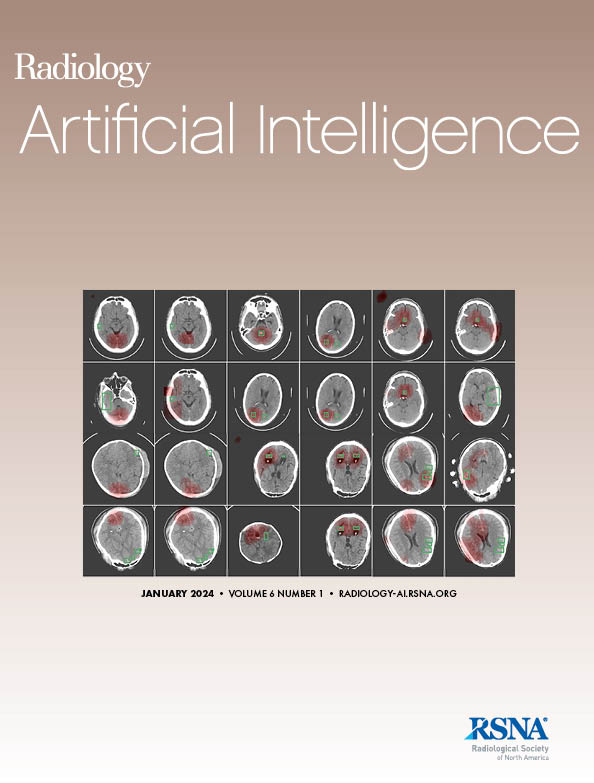Zhehan Shen, Lingzhi Chen, Lilong Wang, Shunjie Dong, Fakai Wang, Yaning Pan, Jiahao Zhou, Yikun Wang, Xinxin Xu, Huanhuan Chong, Huimin Lin, Weixia Li, Ruokun Li, Haihong Ma, Jing Ma, Yixing Yu, Lianjun Du, Xiaosong Wang, Shaoting Zhang, Fuhua Yan
求助PDF
{"title":"多参数MRI诊断局灶性肝脏病变的可解释深度学习模型。","authors":"Zhehan Shen, Lingzhi Chen, Lilong Wang, Shunjie Dong, Fakai Wang, Yaning Pan, Jiahao Zhou, Yikun Wang, Xinxin Xu, Huanhuan Chong, Huimin Lin, Weixia Li, Ruokun Li, Haihong Ma, Jing Ma, Yixing Yu, Lianjun Du, Xiaosong Wang, Shaoting Zhang, Fuhua Yan","doi":"10.1148/ryai.240531","DOIUrl":null,"url":null,"abstract":"<p><p>Purpose To assess the effectiveness of an explainable deep learning (DL) model, developed using multiparametric MRI (mpMRI) features, in improving diagnostic accuracy and efficiency of radiologists for classification of focal liver lesions (FLLs). Materials and Methods FLLs ≥ 1 cm in diameter at mpMRI were included in the study. nn-Unet and Liver Imaging Feature Transformer (LIFT) models were developed using retrospective data from one hospital (January 2018-August 2023). nnU-Net was used for lesion segmentation and LIFT for FLL classification. External testing was performed on data from three hospitals (January 2018-December 2023), with a prospective test set obtained from January 2024 to April 2024. Model performance was compared with radiologists and impact of model assistance on junior and senior radiologist performance was assessed. Evaluation metrics included the Dice similarity coefficient (DSC) and accuracy. Results A total of 2131 individuals with FLLs (mean age, 56 ± [SD] 12 years; 1476 female) were included in the training, internal test, external test, and prospective test sets. Average DSC values for liver and tumor segmentation across the three test sets were 0.98 and 0.96, respectively. Average accuracy for features and lesion classification across the three test sets were 93% and 97%, respectively. LIFT-assisted readings improved diagnostic accuracy (average 5.3% increase, <i>P</i> < .001), reduced reading time (average 34.5 seconds decrease, <i>P</i> < .001), and enhanced confidence (average 0.3-point increase, <i>P</i> < .001) of junior radiologists. Conclusion The proposed DL model accurately detected and classified FLLs, improving diagnostic accuracy and efficiency of junior radiologists. ©RSNA, 2025.</p>","PeriodicalId":29787,"journal":{"name":"Radiology-Artificial Intelligence","volume":" ","pages":"e240531"},"PeriodicalIF":13.2000,"publicationDate":"2025-09-10","publicationTypes":"Journal Article","fieldsOfStudy":null,"isOpenAccess":false,"openAccessPdf":"","citationCount":"0","resultStr":"{\"title\":\"An Explainable Deep Learning Model for Focal Liver Lesion Diagnosis Using Multiparametric MRI.\",\"authors\":\"Zhehan Shen, Lingzhi Chen, Lilong Wang, Shunjie Dong, Fakai Wang, Yaning Pan, Jiahao Zhou, Yikun Wang, Xinxin Xu, Huanhuan Chong, Huimin Lin, Weixia Li, Ruokun Li, Haihong Ma, Jing Ma, Yixing Yu, Lianjun Du, Xiaosong Wang, Shaoting Zhang, Fuhua Yan\",\"doi\":\"10.1148/ryai.240531\",\"DOIUrl\":null,\"url\":null,\"abstract\":\"<p><p>Purpose To assess the effectiveness of an explainable deep learning (DL) model, developed using multiparametric MRI (mpMRI) features, in improving diagnostic accuracy and efficiency of radiologists for classification of focal liver lesions (FLLs). Materials and Methods FLLs ≥ 1 cm in diameter at mpMRI were included in the study. nn-Unet and Liver Imaging Feature Transformer (LIFT) models were developed using retrospective data from one hospital (January 2018-August 2023). nnU-Net was used for lesion segmentation and LIFT for FLL classification. External testing was performed on data from three hospitals (January 2018-December 2023), with a prospective test set obtained from January 2024 to April 2024. Model performance was compared with radiologists and impact of model assistance on junior and senior radiologist performance was assessed. Evaluation metrics included the Dice similarity coefficient (DSC) and accuracy. Results A total of 2131 individuals with FLLs (mean age, 56 ± [SD] 12 years; 1476 female) were included in the training, internal test, external test, and prospective test sets. Average DSC values for liver and tumor segmentation across the three test sets were 0.98 and 0.96, respectively. Average accuracy for features and lesion classification across the three test sets were 93% and 97%, respectively. LIFT-assisted readings improved diagnostic accuracy (average 5.3% increase, <i>P</i> < .001), reduced reading time (average 34.5 seconds decrease, <i>P</i> < .001), and enhanced confidence (average 0.3-point increase, <i>P</i> < .001) of junior radiologists. Conclusion The proposed DL model accurately detected and classified FLLs, improving diagnostic accuracy and efficiency of junior radiologists. ©RSNA, 2025.</p>\",\"PeriodicalId\":29787,\"journal\":{\"name\":\"Radiology-Artificial Intelligence\",\"volume\":\" \",\"pages\":\"e240531\"},\"PeriodicalIF\":13.2000,\"publicationDate\":\"2025-09-10\",\"publicationTypes\":\"Journal Article\",\"fieldsOfStudy\":null,\"isOpenAccess\":false,\"openAccessPdf\":\"\",\"citationCount\":\"0\",\"resultStr\":null,\"platform\":\"Semanticscholar\",\"paperid\":null,\"PeriodicalName\":\"Radiology-Artificial Intelligence\",\"FirstCategoryId\":\"1085\",\"ListUrlMain\":\"https://doi.org/10.1148/ryai.240531\",\"RegionNum\":0,\"RegionCategory\":null,\"ArticlePicture\":[],\"TitleCN\":null,\"AbstractTextCN\":null,\"PMCID\":null,\"EPubDate\":\"\",\"PubModel\":\"\",\"JCR\":\"Q1\",\"JCRName\":\"COMPUTER SCIENCE, ARTIFICIAL INTELLIGENCE\",\"Score\":null,\"Total\":0}","platform":"Semanticscholar","paperid":null,"PeriodicalName":"Radiology-Artificial Intelligence","FirstCategoryId":"1085","ListUrlMain":"https://doi.org/10.1148/ryai.240531","RegionNum":0,"RegionCategory":null,"ArticlePicture":[],"TitleCN":null,"AbstractTextCN":null,"PMCID":null,"EPubDate":"","PubModel":"","JCR":"Q1","JCRName":"COMPUTER SCIENCE, ARTIFICIAL INTELLIGENCE","Score":null,"Total":0}
引用次数: 0
引用
批量引用

 求助内容:
求助内容: 应助结果提醒方式:
应助结果提醒方式:


